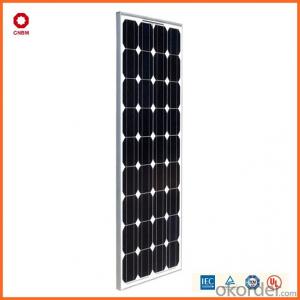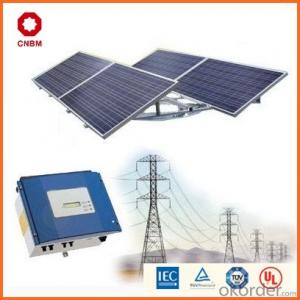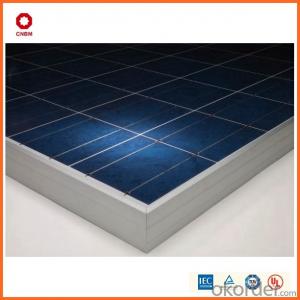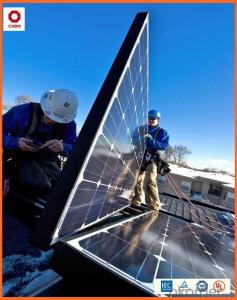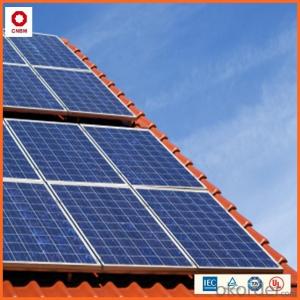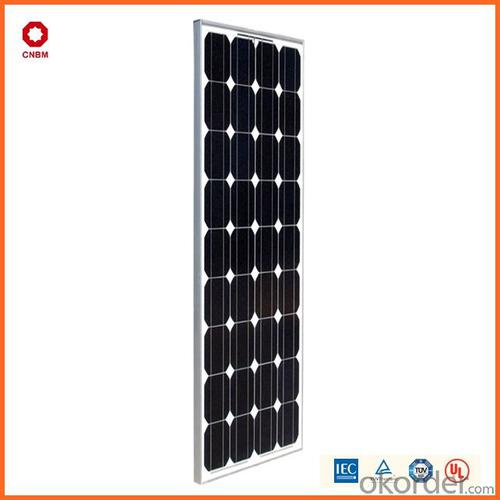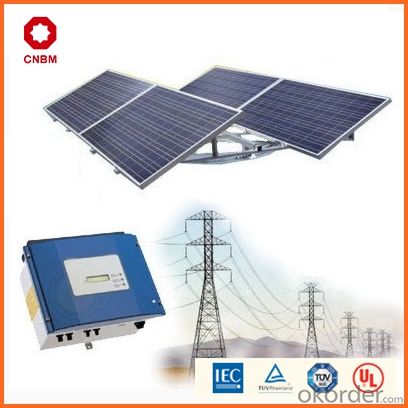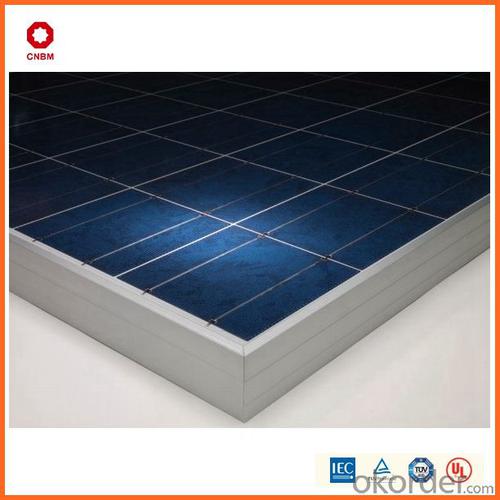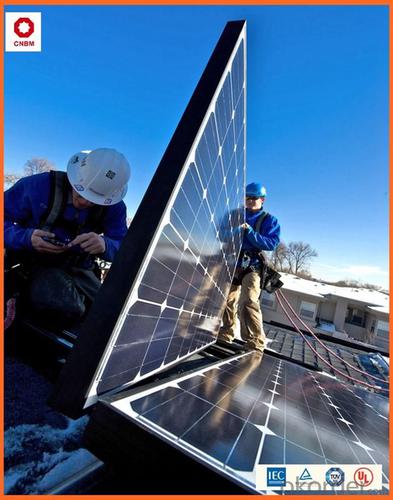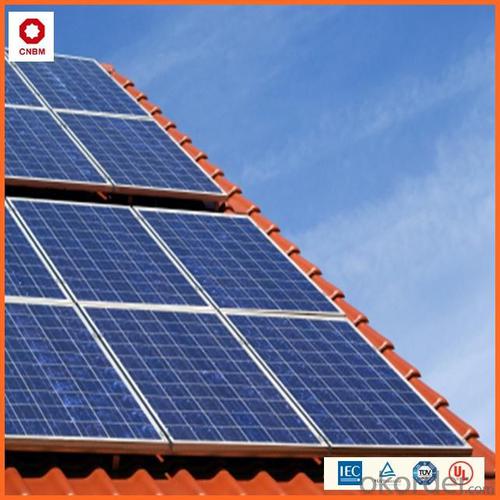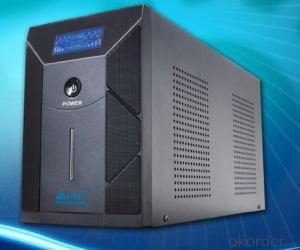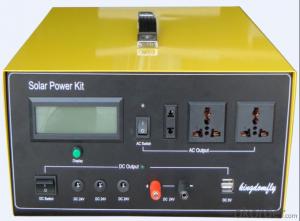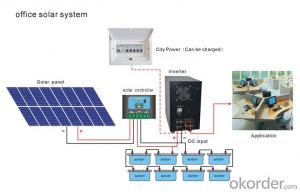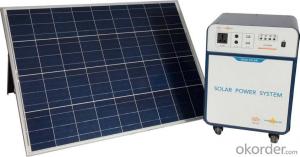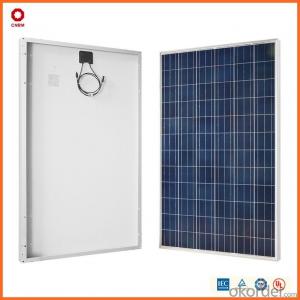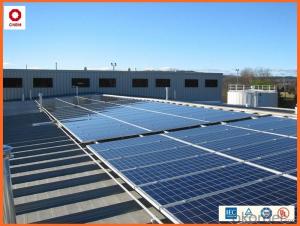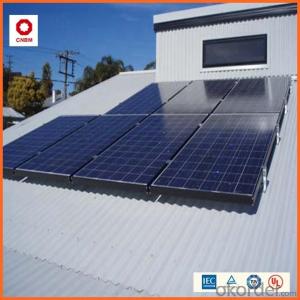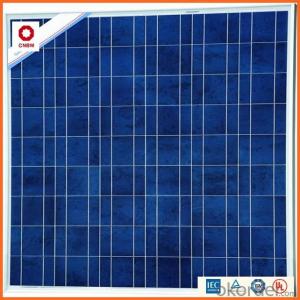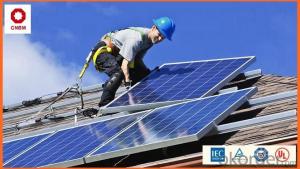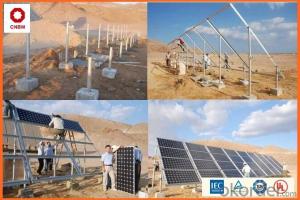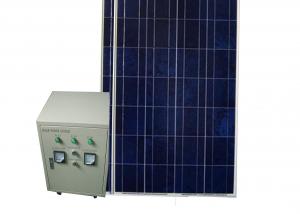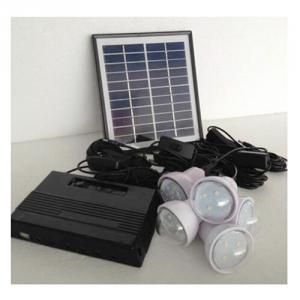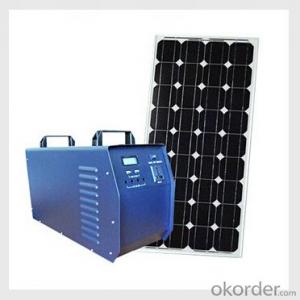75w Small Solar Panels in Stock - Solar Energy Systems New York - China Manufacturer
- Loading Port:
- China main port
- Payment Terms:
- TT OR LC
- Min Order Qty:
- 1 watt
- Supply Capability:
- 10000000 watt/month
OKorder Service Pledge
OKorder Financial Service
You Might Also Like
Specification
Product Description:
Hot Sale !!! Quality and Safety of Small Poly Solar Panel 5w~150w
1. Rigorous quality control meets the highest international standards.
2. High-transmissivity low-iron tempered glass, strong aluminium frame.
3. Using UV-resistant silicon.
4. IS09001/14001/CE/TUV/UL
Warranties of Small Poly Solar Panel 35~85w
1. 10 years limited product warranty
2. 15 years at 90% of the minimal rated power output
3. 25 years at 80% of the minimal rated power output
Specification
Characteristics of Poly solar panels CNBM (245-320W) | |||||
Max Power Voltage Vmp(V) | 30.3 | 30.8 | 31.1 | 31.4 | 31.85 |
Max Power Current Imp(A) | 7.60 | 7.64 | 7.73 | 7.81 | 7.85 |
Open Circuit Voltage Voc(V) | 36.1 | 36.6 | 37 | 37.3 | 37.68 |
Short Circuit Current Isc(A) | 8.50 | 8.55 | 8.65 | 8.75 | 8.85 |
Max Power Pm(W) | 230W | 235W | 240W | 245W | 250W |
Temperature Coefficient of Cells Poly solar panels CNBM (245-320W) | |
NOCT | 45± 2 |
Temperature Coeffucients of Isc | 0.0492 |
Temperature Coeffucients of Voc | -0.3374 |
Temperature Coeffucients of Voc | -0.4677 |
Mechanical Data of Poly solar panels CNBM (245-320W) | |
Dimension | 1638 × 982 × 40 mm |
Weight | 19.5 kg |
No. of Cells and Connections | 60 (6 ×10) |
Tolerance | 0 ~ + 5 W |
Cell | Monocrystalline Cell 156 × 156 mm |
Packing | 624 Pcs/40ft(H) Container |
Limits of Poly solar panels CNBM (245-320W) | |
Operating Temperature | -40 to +85 |
Storage Temperature | -40 to +85 |
Max System Voltage | 1000VDC(IEC) / 600VDC(UL) |
Features of our products:
• High conversion efficiency mono/poly-crystalline amorphous silicon solar cells
• Modules incorporate high performance bypass diodes to minimize the power drop caused by shading
• High transmittance, low-iron tempered glass
• High performance EVA encapsulant to prevent destroying and water.
• AI frame: without screw, corner connection. 8 holes on the frame can be installed easily
• Good performance of preventing from atrocious weather such as wind and hails
• Certifications: CE IEC TUV VDE UL, Class I
• 10 years 90% power output warranty
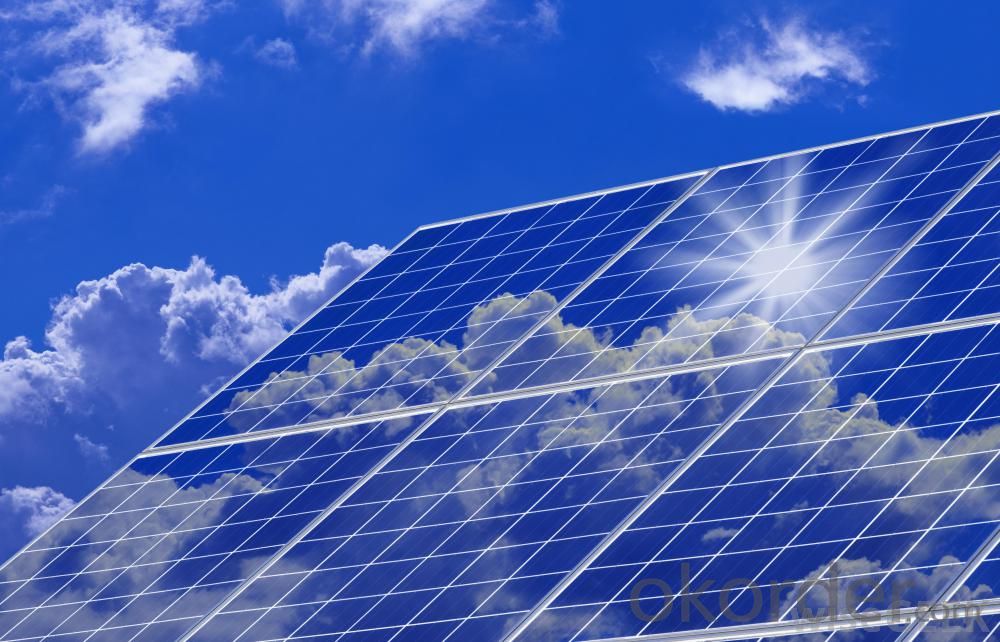
Shipping of Small Poly Solar Panel 35~85w
By Sea | Delivery from Shanghai or Ningbo seaport |
By Air | Departure from Shanghai Pudong Airport |
By Express | Post by DHL, EMS, UPS, TNT. |
Features of our products:
• High conversion efficiency mono/poly-crystalline amorphous silicon solar cells
• Modules incorporate high performance bypass diodes to minimize the power drop caused by shading
• High transmittance, low-iron tempered glass
• High performance EVA encapsulant to prevent destroying and water.
• AI frame: without screw, corner connection. 8 holes on the frame can be installed easily
• Good performance of preventing from atrocious weather such as wind and hails
• Certifications: CE IEC TUV VDE UL, Class I
• 10 years 90% power output warranty
As a professional Solar Panel manufacturer and Supplier in China, we have our customers come around the whole world and our specialization has got a worldwide recognition. Meanwhile, with our superior quality, competitive price, prompt and excellent service, As main role in trade section of CNBM Group, CNBM International Corporation supplies products including Monocrystalline Solar Panel, Polycrystalline Solar Panel ( multicrystalline silicon Solar Panel) have received and enjoyed famous reputation in many countries and regions in the world.
- Q: What is the role of solar-powered water purification systems in providing clean drinking water?
- Solar-powered water purification systems play a crucial role in providing clean drinking water by harnessing the energy from the sun to remove impurities and pathogens from water sources. These systems use solar panels to generate electricity, which powers various purification technologies such as filtration, disinfection, and reverse osmosis. By relying on renewable energy, solar-powered water purification systems can operate in remote areas without access to electricity, making them a sustainable and cost-effective solution. Moreover, these systems reduce dependence on traditional fuel sources and contribute to mitigating environmental pollution. Overall, solar-powered water purification systems are instrumental in ensuring access to safe and clean drinking water, particularly in regions facing water scarcity or contamination issues.
- Q: Are there any insurance considerations for solar energy systems?
- Yes, there are insurance considerations for solar energy systems. Installing a solar energy system typically requires additional insurance coverage to protect against any potential damages or accidents. This can include coverage for the solar panels themselves, liability coverage for any injuries or property damage caused by the system, and potential business interruption coverage in case the system fails or is damaged. It is important for homeowners, businesses, and solar energy providers to consult with their insurance providers to ensure they have the appropriate coverage in place.
- Q: Can solar energy systems be used for powering off-grid eco-farms?
- Yes, solar energy systems can definitely be used for powering off-grid eco-farms. Solar panels can be installed to harness sunlight and convert it into electricity, which can then be used to power various farm operations such as irrigation systems, lighting, ventilation, and machinery. This renewable energy source is ideal for off-grid eco-farms as it reduces dependence on fossil fuels, minimizes environmental impact, and offers a sustainable solution for meeting energy needs in remote farming locations.
- Q: How do solar energy systems affect the insurance premiums of a property?
- Solar energy systems can have a positive impact on insurance premiums for a property. By installing solar panels, the property becomes more environmentally friendly and less dependent on traditional energy sources, reducing the risk of damage or loss associated with power outages or utility failures. This can lead to lower insurance premiums as insurers recognize the decreased risk. Additionally, some insurance companies offer specialized policies or discounts specifically for properties with solar energy systems, further reducing premiums.
- Q: How much maintenance is required for a solar energy system?
- A solar energy system requires minimal maintenance. Regular cleaning of solar panels and occasional inspections to ensure optimal performance are recommended. Generally, solar panels have no moving parts, reducing the need for repairs or replacements. However, periodic checks of the inverter and electrical connections are necessary. Overall, the maintenance requirements for a solar energy system are relatively low compared to other power generation methods.
- Q: How do solar energy systems impact energy policy and regulation?
- Solar energy systems have a significant impact on energy policy and regulation by promoting the adoption of renewable energy sources and reducing dependence on fossil fuels. Governments and regulatory bodies often implement policies and regulations that incentivize the installation and use of solar energy systems, such as feed-in tariffs or tax credits. This helps to accelerate the transition to clean energy and achieve sustainability goals. Additionally, solar energy systems can influence the development of grid infrastructure and energy storage technologies to accommodate the intermittent nature of solar power, leading to a more resilient and decentralized energy system.
- Q: What are the different installation requirements for solar energy systems?
- Solar energy systems have varying installation requirements depending on the specific type, size, location, and local regulations. However, there are general requirements that apply to most systems. Firstly, it is crucial to find a suitable location for solar panel installation. Ideally, the panels should be placed in an area that receives ample direct sunlight throughout the day. Commonly, solar panels are installed on roofs, but ground-mounted systems are also possible. The roof or ground where the panels will be installed must be structurally sound and capable of supporting their weight. If the system is roof-mounted, the roof should be in good condition and able to handle the added weight and potential wind loads. Any necessary repairs or reinforcement should be done before installation. To maximize sunlight exposure, the solar panels should be positioned to face south in the northern hemisphere or north in the southern hemisphere in most cases. The optimal tilt angle will depend on the latitude of the installation site and should be adjusted accordingly. Proper installation of electrical wiring and connections is essential and must comply with local electrical codes and regulations. This includes using appropriate wiring, junction boxes, and disconnect switches. It is advisable to hire a licensed electrician to handle the electrical aspects of the installation. Depending on the specific system, additional components such as inverters, batteries, and charge controllers may be necessary. These components should be correctly sized and installed according to the manufacturer's instructions and local regulations. Lastly, it is important to obtain any required permits and approvals from local authorities before installing a solar energy system. This may include building permits, electrical permits, and inspections to ensure compliance with safety and quality standards. In summary, the installation requirements for solar energy systems involve selecting a suitable location, ensuring structural integrity, optimizing orientation and tilt, complying with electrical codes, installing additional components when needed, and obtaining necessary permits and approvals. Working with a qualified solar installer is recommended to ensure a safe and efficient installation and to receive expert guidance.
- Q: Can solar energy systems be installed on airports or transportation hubs?
- Yes, solar energy systems can be installed on airports or transportation hubs. In fact, many airports around the world have already embraced solar power as a clean and sustainable energy source. These systems can be installed on rooftops, parking lots, or even as ground-mounted arrays near the facilities. Solar energy can help airports and transportation hubs reduce their carbon footprint, lower energy costs, and contribute to a greener and more sustainable future.
- Q: Can solar energy systems be used in areas with limited access to sunlight due to tall nearby buildings or trees?
- Solar energy systems can still be utilized in areas with limited sunlight due to tall buildings or trees. Although shading can reduce solar panel efficiency, there are various solutions to overcome this obstacle. To begin, solar panels can be strategically placed on rooftops or other elevated structures to minimize the impact of shading. By positioning the panels in areas that receive the most sunlight throughout the day, such as the southern side of a building or open spaces, shading effects can be minimized. Furthermore, advancements in solar technology have resulted in the creation of more efficient and flexible solar panels. Some panels are specifically designed to function in low-light conditions, enabling them to generate electricity even in areas with limited sunlight. Moreover, the use of solar tracking systems can significantly improve the performance of solar energy systems in shaded areas. These systems allow the solar panels to follow the sun's movement throughout the day, ensuring they are constantly exposed to the maximum sunlight available. Lastly, it is important to note that a comprehensive site assessment and professional design can help determine the best options for solar energy systems in shaded areas. By thoroughly analyzing the site conditions and considering factors such as shading intensity, angle of incidence, and available space, a customized solar energy system can be designed to optimize energy generation, even in areas with limited sunlight access.
- Q: How do solar energy systems impact the reliability of electricity supply during blackouts?
- The reliability of electricity supply during blackouts can be positively influenced by solar energy systems. Homeowners and businesses can access electricity even when the grid goes down if they have a properly installed solar energy system. This is because solar panels generate electricity from sunlight, making them independent of the traditional power grid. When the sun is shining during the day, solar panels can produce electricity to meet the electrical needs of a home or business. Any excess energy generated can be stored in batteries for later use. This stored energy can then be utilized at night or during power outages, ensuring a reliable source of electricity when the grid is down. Furthermore, solar energy systems can be equipped with an inverter and a smart system that allows them to disconnect from the grid in the event of a blackout. This process, known as islanding, allows the solar panels to continue generating electricity for local consumption while isolating themselves from the main power grid. This feature guarantees that solar-powered homes and businesses can continue operating even during grid outages. The reliability of solar energy systems during blackouts depends on the size and capacity of the system, as well as the amount of energy stored in the batteries. Larger solar systems with ample battery storage can provide extended periods of electricity supply during blackouts, while smaller systems may only offer power for a limited time. It is worth noting that the reliability of solar energy systems during blackouts also relies on regular maintenance and inspections. Ensuring that the solar panels, batteries, and other components are functioning properly will optimize their performance during power outages. In conclusion, solar energy systems significantly enhance the reliability of electricity supply during blackouts. They provide a sustainable and independent source of electricity, reducing reliance on the grid and increasing resilience in the face of power disruptions.
Send your message to us
75w Small Solar Panels in Stock - Solar Energy Systems New York - China Manufacturer
- Loading Port:
- China main port
- Payment Terms:
- TT OR LC
- Min Order Qty:
- 1 watt
- Supply Capability:
- 10000000 watt/month
OKorder Service Pledge
OKorder Financial Service
Similar products
Hot products
Hot Searches
Related keywords
